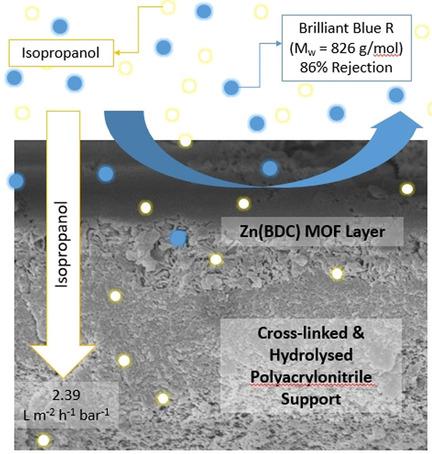当前位置:
X-MOL 学术
›
ChemSusChem
›
论文详情
Our official English website, www.x-mol.net, welcomes your feedback! (Note: you will need to create a separate account there.)
Green Layer‐by‐Layer Method for the Preparation of Polyacrylonitrile‐Supported Zinc Benzene‐1,4‐dicarboxylic Acid Membranes
ChemSusChem ( IF 8.4 ) Pub Date : 2018-07-10 , DOI: 10.1002/cssc.201800740 Hui Min Tham 1, 2 , Susilo Japip 2 , Dan Hua 2 , Tai‐Shung Chung 1, 2
ChemSusChem ( IF 8.4 ) Pub Date : 2018-07-10 , DOI: 10.1002/cssc.201800740 Hui Min Tham 1, 2 , Susilo Japip 2 , Dan Hua 2 , Tai‐Shung Chung 1, 2
Affiliation

|
Ultrafiltration‐level polyacrylonitrile (PAN) flat sheet membranes were chemically modified through cross‐linking and hydrolysis to provide a suitable surface for the growth of a selective layer composed of a Zn benzene‐1,4‐dicarboxylic acid (Zn(BDC)) metal‐organic framework (MOF). Unlike typical membrane modification methods or conventional MOF synthesis procedures, deionized (DI) water was the only solvent used for each of the modification steps. To better understand the layer‐by‐layer MOF growth process, several MOF growth conditions were also studied, including the effects of solution concentration, growth temperature, membrane immersion time and the number of layers. Subsequently, organic solvent nanofiltration (OSN) was used to test the effectiveness of the modifications and compare the performances of the fabricated membranes. With the appropriate combination of the MOF growth conditions, the layer‐by‐layer method was used to produce an OSN membrane with an isopropanol permeance of 2.39 L m−2 h−1 bar−1 and an 86 % rejection of the dye Brilliant Blue R (Mw 825.97 g mol−1).
中文翻译:

绿色层法制备聚丙烯腈负载的苯-1,4-二羧酸锌膜
通过交联和水解对超滤级聚丙烯腈(PAN)平板膜进行了化学修饰,从而为由Zn苯-1,4-二羧酸(Zn(BDC))金属组成的选择性层的生长提供了合适的表面。有机框架(MOF)。与典型的膜修饰方法或常规MOF合成程序不同,去离子(DI)水是用于每个修饰步骤的唯一溶剂。为了更好地了解MOF的逐层生长过程,还研究了几种MOF生长条件,包括溶液浓度,生长温度,膜浸入时间和层数的影响。随后,使用有机溶剂纳滤(OSN)来测试修饰的有效性并比较制成膜的性能。-2 ħ -1 巴-1和86%截留的染料马斯亮蓝R的(M的瓦特825.97克摩尔-1)。
更新日期:2018-07-10
中文翻译:

绿色层法制备聚丙烯腈负载的苯-1,4-二羧酸锌膜
通过交联和水解对超滤级聚丙烯腈(PAN)平板膜进行了化学修饰,从而为由Zn苯-1,4-二羧酸(Zn(BDC))金属组成的选择性层的生长提供了合适的表面。有机框架(MOF)。与典型的膜修饰方法或常规MOF合成程序不同,去离子(DI)水是用于每个修饰步骤的唯一溶剂。为了更好地了解MOF的逐层生长过程,还研究了几种MOF生长条件,包括溶液浓度,生长温度,膜浸入时间和层数的影响。随后,使用有机溶剂纳滤(OSN)来测试修饰的有效性并比较制成膜的性能。-2 ħ -1 巴-1和86%截留的染料马斯亮蓝R的(M的瓦特825.97克摩尔-1)。



























 京公网安备 11010802027423号
京公网安备 11010802027423号